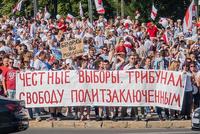We are proudly re-posting an analysis by our Georgetown UC Fellow Sam Kramer. The text is focused on events in Belarus and was originally published at UpNorth.eu. Enjoy!
Turmoil marred the oft-ignored Belarusian presidential elections as Sviatlana Tsikhanouskaya, the wife of an arrested presidential candidate, challenges incumbent Alyaksandr Lukashenka. As popular protests face state violence and allegations of falsified votes grow louder, parallels appear with Ukraine’s 2013-2014 Euromaidan Revolution. Several factors, however, make the Belarusian case unique in the annals of Eastern European democratization. Instead of modeling Belarus’ transition on the Ukrainian Euromaidan, reformers should look back to early post-Communist transitions.
Belarus and Ukraine: Different Stages
The most critical difference between current events in Belarus and the Ukrainian Euromaidan is that the Euromaidan was built on a decade-old foundation of multiparty elections and institutionalism. Belarus remains a de facto non-partisan autocracy. President Lukashenka has been re-elected five times and has centralized the state around his presidency. Public opinion appears apolitical: in 1993, the year before Lukashenka took power, then-head of state Stanislav Shushkevich claimed that 60% of people did not support any political party. In the 2020 elections, most of the challengers, including Tsikhanouskaya, are independents.

Pre-Euromaidan Ukraine by contrast was classified by political scientists as a “hybrid regime” sharing aspects of authoritarian rule with democratic competition. The country had multiparty elections, began considering decentralization reforms even before the Euromaidan, and saw civil society provide a counter in the 2004 Orange Revolution when the pro-government candidate Viktor Yanukovych was forced into a run-off election. Solid democratic institutions need to be formed if Belarus attempts any reforms. Civic engagement and a multiparty political infrastructure are essential to ending the Soviet-style system in post-1994 Belarus.
Please find the rest of the text here